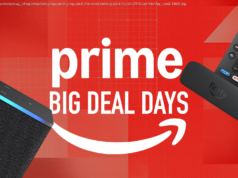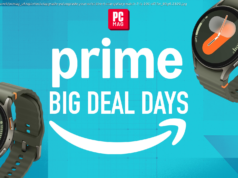Ahead of the Consumer Electronics Show this week, HTC unveiled its new Vive Pro headset and Wireless Adaptor along with interface improvements for its Viveport VR marketplace and Vive Video browser. The Pro’s resolution is 78 percent higher than the current Vive headset, and it also features built-in headphones and a more comfortable form factor. With the wireless adapter, both headsets can also be untethered.
Ahead of the Consumer Electronics Show this week, HTC unveiled its new Vive Pro headset and Wireless Adaptor along with interface improvements for its Viveport VR marketplace and Vive Video browser. The Pro’s resolution is 78 percent higher than the current Vive headset, and it also features built-in headphones and a more comfortable form factor. With the wireless adapter, both headsets can also be untethered.
The ability to go wireless plus the marketplace improvements can improve the VR experiences of the everyday consumer, but the Pro will likely be a pricier headset and is geared more toward high-end and business users.
In the HTC showroom, a mix of games and enterprise solutions were on display, showcasing Doom VFR across the way from a forklift training simulation. In an interview with HTC’s general manager for the American region Dan O’Brien and director of VR Troy Edwards, I asked what these improvements mean for the company moving forward and what we can expect from VR in 2018.
Here is an edited transcript of our interview at CES.
GamesBeat: What’s next, now that you have the higher resolution with the Vive Pro? What challenges are you tackling?
Dan O’Brien: I think this year, with CES, with the Pro, we wanted to tackle resolution, increasing the pixel density, the clarity, being able to handle use cases like reading text and going into details of design elements in what our enterprise and professional customers are asking us to do. And then we wanted to solve for audio. Bring a much better inline amplifier experience to those headphones. Those are really great-sounding headphones. But we also wanted to fix the ergonomics of the new design, so professionals and consumers can wear it for extended periods of time.
We made it easy to adjust for your own fit and comfort. Just simple things like hitting a button on the bottom of the headset and being able to adjust it away from your eyeglasses, and then adjust it back really quickly. I wear glasses at night. My son and I will hot swap the headset all the time, and he has perfect vision. It just makes it easier for movement in and out.
A lot of developers are taking the headset on and off, on and off. They want to be able to do that quickly. In terms of doing that, we wanted to make a lot of improvements to a new headset, bring that to market, really for the professional. That’s why we ultimately called it the Pro, because that’s who we built it for. But also just solving wireless. We wanted to make that a better experience, make it seamless.
We had the partnership with Intel and built this product with the WiGig wireless protocol. It’s a great experience. It’s built on the 60Ghz band, so you have this really fluid signal. The frequency is uninterrupted in busy environments. You really have a great experience from a wireless perspective. Those things, making it more comfortable, making the audio better, making the visuals better, making the wireless better, those are all things that are going to make VR adoption a lot better.
GamesBeat: How do you think it will affect content? Like you said, it’s a lot more comfortable. It’s going to be wireless with the wireless adapter. Will we start seeing longer VR experiences?
O’Brien: I think developers will be more comfortable putting people in longer experiences. With the launch of Fallout 4 VR, that’s been on the market three or four weeks now. You’re talking a hundred hours of gameplay. We’re now seeing triple-A studios like Rockstar, like Bethesda—Bethesda came out with Doom as well. You’re seeing those long format, really rich big environments. You’re seeing second and third generation content from the indie market like Cloudhead and Gallery 2. You’re seeing long format, richer stories, richer experiences. Those are all continuing to grow.
Troy Edwards: And for developers, I think there’s a standard way they’re approaching text and tutorials in games. As higher resolution proliferates they’ll be able to change how they approach that. You’ll be able to use more text. In particular, for enterprise customers, they’ve told us they want to be able to use spec docs in VR. They want to showroom their cars. We did an event a couple of weeks ago with Cessna. They were showing a $26 million airplane with their VR experience, and their first question was, when are we going to get something that looks more like our plane, because of the higher resolution? We think those customers in particular are really excited for the increase in resolution.
GB: Are you going to try to get arcade operators to adopt the Wireless Adaptor?
O’Brien: We think arcades will very likely gravitate toward something like that. It is a better experience when you can show multi-user—we’re also showing things like Base Station 2.0 in the room today for the first time. There, you can actually connect four base stations and cover an area of 10 meters by 10 meters. So in our mixed reality bay we actually have three people in there right now playing Arizona Sunshine. One person is on wireless, one person is on a backpack, and one person has a wired kit. Arcades are definitely going to find this very useful for their environments, social experiences, multiplayer users. It’s going to be foundationally changing for them.
GamesBeat: Does this mean we won’t see the Vive Focus in the West?
O’Brien: Right now we’re just going to have Focus in China. We’re going to learn a lot about our users there, usage, what they think of it, learnings about it. I think the all-in-one category is extremely important to VR. We’re excited about putting that product in China, in that market, and seeing how it does, getting feedback from developers and users, learning more about it, and seeing how we apply to that other markets and regions.
GamesBeat: You mentioned text and UI, things developers can do now with wireless and the better form factor. Can you talk about Viveport VR, this VR native way of previewing content, and how you’re designing UI and UX for players?
O’Brien: The Viveport experience, it’s really thinking about VR first. Instead of having just a 2D panel and selecting things, it’s a better way to experience the content that you may be interested in making a purchase decision for. So it’s a way for users to search for content in a more intuitive way, to identify the different categories they might be interested in, and then being able to actually hit a preview button and have that experience.
One of the examples we showed yesterday was Jerusalem. As you click the VR preview button, the whole introductory piece of the environment, that vertical slice of the environment, you get to experience that and say, all right, this seems really interesting, I would like to get this game, and then make your purchase decision from there. It’s about giving the user better decision-making tools to make a purchase decision.
And with Vive Video, we also have the ability, in this partnership with Vimeo, to bring in hundreds of video examples, whether they’re 2D on big screen or 360 video, and start seeing the next video you might like to try within the actual browser, or within the video experience, and browse other videos and click to the next one, be able to search for the next category you might be interested in. It’s a great partnership with them as well.
Edwards: For Viveport VR in particular, if you think about it from a developer perspective, they don’t really have a way to differentiate their experiences today. And so if a developer builds one of the new previews, if you’re looking at content side by side, you’ll be able to get a better slice of that content and a better approximation. In areas like Viveport subscription, where you’re picking five titles a month, you might pick a title that has an interactive preview over one that doesn’t, because you’re making that selection each month. We think it’s going to be a great way for developers to set themselves apart.
GamesBeat: You mentioned Vive Video and the mini browser where users can look at the next video they want to queue up.






